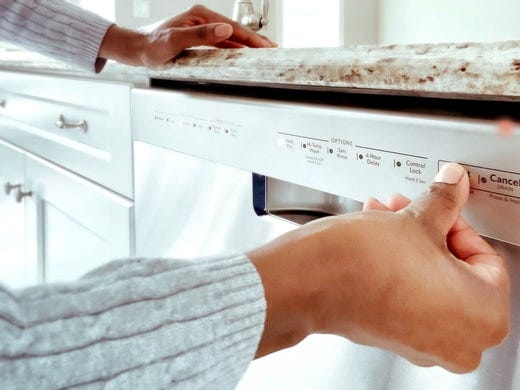
Dishwasher Settings & Cycles
Find out what dishwasher settings and cycles you should be using with every wash, with help from Finish®. Learn how to get sparkly clean every time.

Your dishwasher probably has a number of different functions and settings that you don't use every day. From sanitizing to "quiet" mode, many models offer more settings than just "wash." Although we tend to get into the habit of using the same dishwasher setting over and over, it’s important to understand what your machine is capable of so that your household can get the most out of your model.
Here we'll explain some standard dishwasher settings and common cycles you might find on a modern dishwasher.
Dishwasher eco setting
"Eco-mode" refers to the energy saving setting on a dishwasher. It helps to lower the wash and rinse temperatures during a cycle, thus using less energy than would have otherwise been used to heat the water.1
Does the dishwasher eco setting impact the quality of the clean your dishes will get? Some believe that lower water temperatures won't deliver the same results. However, as long as your dishes are small and not heavily soiled, the eco setting should work just as well as any other setting. So while you can't expect large pots and pans with caked-on food to come out the same, your regular dishes and glassware should come out beautifully. Just keep in mind that dishwasher eco cycles often take longer than regular cycles.
Dishwasher sanitize setting
You might have noticed a sanitize setting on your dishwasher and thought, "Isn't a regular wash good enough to eat off of?" It almost certainly is, however some prefer the guarantee of extra hot water. When you use the sanitize setting, your dishwasher releases an added blast of hot water (up to 150°F) in its final cycle.2
If your machine doesn’t have a specific dishwasher sanitize setting don't worry about it. The regular high-temperature water combined with a powerful Finish® detergent can still combat grease, grime and stubborn food particles to get your dishes sparkling clean.
Dishwasher drying setting
Nothing's more frustrating than having to dry your dishes as they come out of the dishwasher and go back into the cupboard. Luckily, many modern dishwashers come with different drying settings, so you can find the dry cycle that works for you.
Air dry
Mainly found in newer models, the air dry setting automatically pops the door open after a cycle to allow the steam to escape.
Heated rinse
Also, more commonly found in modern dishwashers, a heated rinse setting increases the water temperature towards the end of the cycle. When it’s done, the hot water evaporates quickly, leaving your dishes drier than if cool water were used instead.
Fan dry
The only issue with other dry settings is they can increase your machine's energy output, and thus your energy bill. If you want to avoid this, use the fan dry setting on your machine. When you choose this setting, your machine will use circulated room temperature air to dry your dishes, as opposed to running its internal, energy-zapping heater.
Heat dry
Just as it sounds, the heat dry setting on your dishwasher uses an internal exhaust fan to dry your dishes with heated air. Although this setting is handy to use if you’re going to be out of the house for a considerable time after the dishwasher cycle stops, it’s best to either use the air dry or fan dry settings, or even crack the door open to let the dishes dry naturally.3
Dishwasher cycles
If you've just been pressing "Start" on the same cycle for years, take a moment to learn about other dishwasher cycle settings. You might get cleaner dishes if you use a cycle tailored for their needs!
Most conventional dishwashers come with three standard cycles: light, normal and heavy for larger pots and pans. These settings are each well suited to regular dishes and everyday "dirt," but you might find your model has some of the below dishwasher cleaning cycles, too.
Auto
Like the eco setting, the auto cycle uses a sensor to detect how much dirt is on your dishes, and then adjusts the water temperature and cycle duration accordingly.
Express
The express, or "speedy" cycle, can have your dishes sparkling in as little as 20 minutes. However, this setting is only recommended for lightly soiled dishes that just need a quick clean.
Quiet
Often found in premium dishwashers, "quiet mode," or the silent cycle, claims to reduce the noise your machine makes. This setting is perfect for open plan homes (or homes with sleeping babies).
China/Crystal/Glassware
This cycle uses a lower water temperature to protect your more delicate items (like glassware, china and crystal). Of course, you should avoid putting extra special items in the dishwasher whenever possible.4
Rinse only
Even though this cycle may sound counterintuitive (remember: you shouldn’t rinse your dishes before putting them in the dishwasher), it’s actually a good way to ensure you don’t end up with a smelly dishwasher. The rinse cycle uses no detergent and very little water and power to splash your dishes as they sit in the machine, waiting for a wash cycle. This means you can hold off until you have a full load to run your dishwasher, without the hassle of letting your dishes fester in the machine.5
Delay start
The "delay start" setting enables you to set a timer that will activate a pre-selected cycle. This option is particularly handy if you choose to wash your dishes at night, when your electricity plan is often cheaper.6
Now that you understand your dishwasher’s settings and cycles, learn more about the signs and symbols that feature on your machine.
1 http://dishwasherreviews.co.uk/need-know-dishwasher-programs.html
2 https://homeguides.sfgate.com/dishwashers-sterilize-84323.html
3 https://www.hunker.com/12145906/how-does-a-dishwasher-dry
4 https://www.reviewed.com/dishwashers/features/everything-you-need-to-know-about-dishwasher-cycles
5 https://www.reviewed.com/dishwashers/features/youre-not-using-your-dishwasher-rinse-cycle-enough
6 https://www.cnet.com/how-to/this-is-what-all-those-buttons-on-your-dishwasher-do/